Nursing Assignment: An Evaluation of the Close the Gap Policy
VerifiedAdded on 2020/02/24
|9
|2433
|350
Essay
AI Summary
This nursing assignment delves into the Australian government's 'Close the Gap' policy, designed to reduce health and social disparities faced by Aboriginal and Torres Strait Islander peoples. The essay explores the policy's aims, including improving life expectancy, reducing child mortality, and increasing access to education and healthcare. It examines the historical context of discrimination and colonization, highlighting the unique challenges faced by Indigenous communities. The assignment specifically focuses on the prevalence of ear diseases, particularly otitis media, among Indigenous children and the policy's efforts to address this issue through screening, vaccination, and treatment programs. It also discusses the challenges in implementing the policy, such as data collection inaccuracies, cultural differences, and workforce disparities. The essay concludes by emphasizing the potential of the Close the Gap program to improve the health and well-being of Indigenous Australians, while acknowledging the need for continued government support, community participation, and culturally sensitive healthcare practices. The essay also references various research studies and reports to support its arguments.
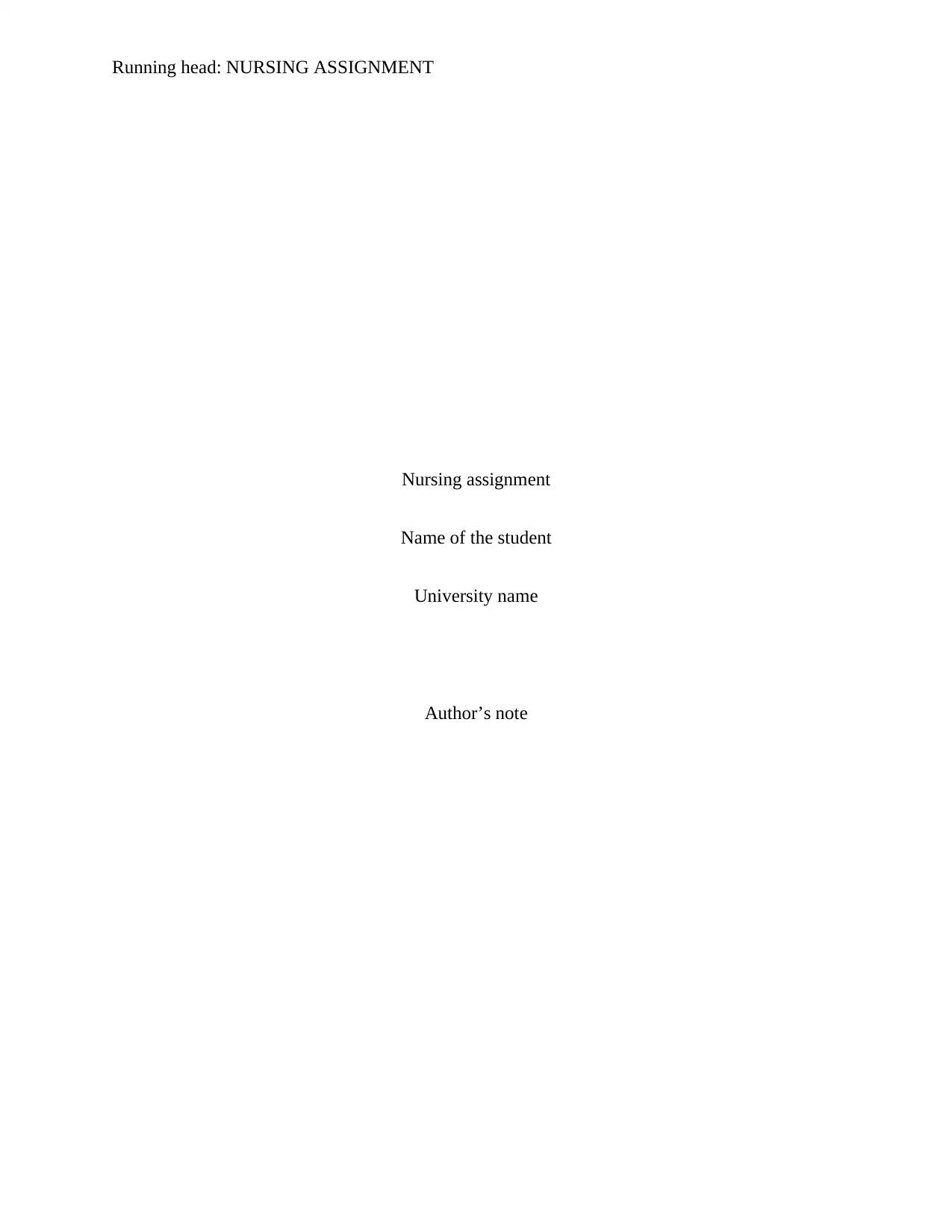
Running head: NURSING ASSIGNMENT
Nursing assignment
Name of the student
University name
Author’s note
Nursing assignment
Name of the student
University name
Author’s note
Paraphrase This Document
Need a fresh take? Get an instant paraphrase of this document with our AI Paraphraser
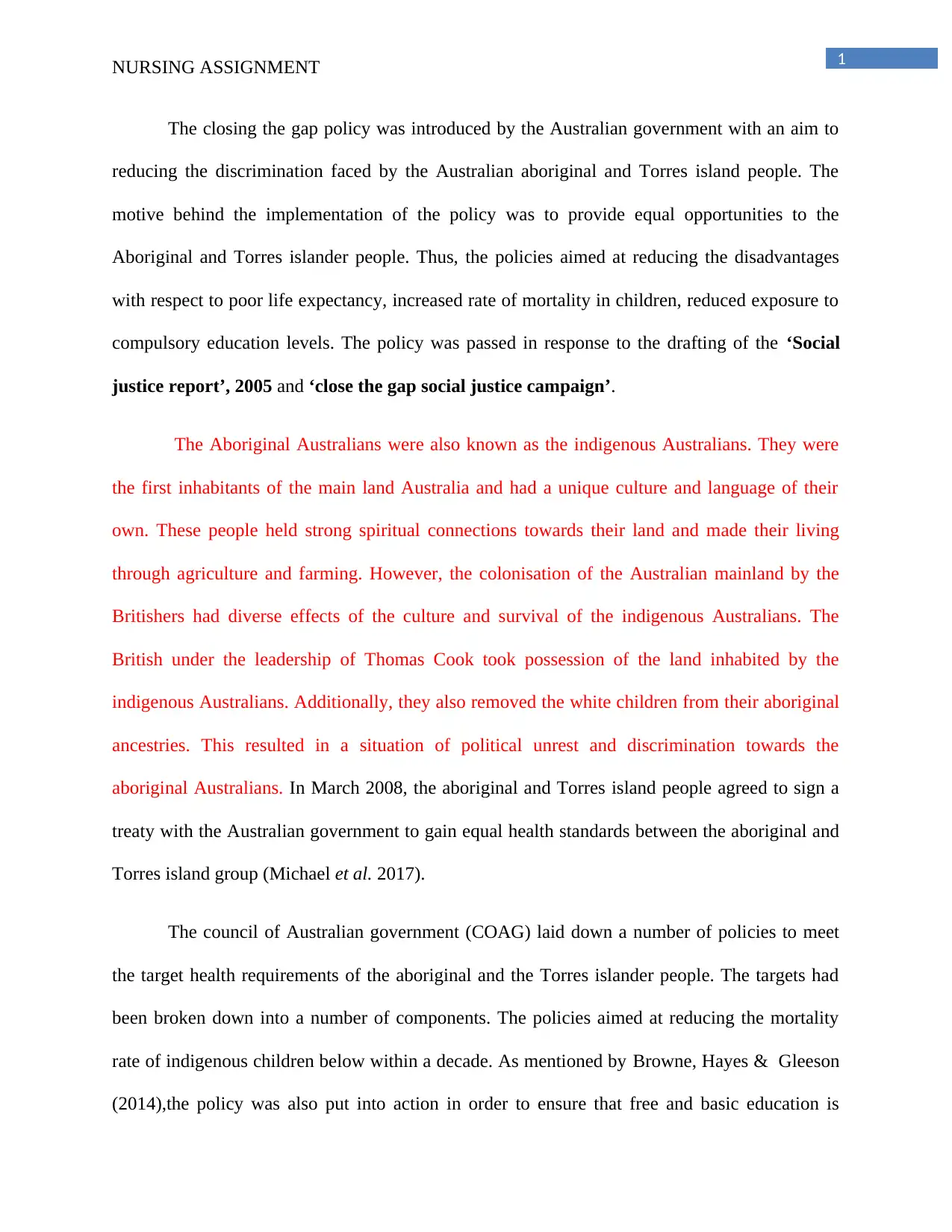
1NURSING ASSIGNMENT
The closing the gap policy was introduced by the Australian government with an aim to
reducing the discrimination faced by the Australian aboriginal and Torres island people. The
motive behind the implementation of the policy was to provide equal opportunities to the
Aboriginal and Torres islander people. Thus, the policies aimed at reducing the disadvantages
with respect to poor life expectancy, increased rate of mortality in children, reduced exposure to
compulsory education levels. The policy was passed in response to the drafting of the ‘Social
justice report’, 2005 and ‘close the gap social justice campaign’.
The Aboriginal Australians were also known as the indigenous Australians. They were
the first inhabitants of the main land Australia and had a unique culture and language of their
own. These people held strong spiritual connections towards their land and made their living
through agriculture and farming. However, the colonisation of the Australian mainland by the
Britishers had diverse effects of the culture and survival of the indigenous Australians. The
British under the leadership of Thomas Cook took possession of the land inhabited by the
indigenous Australians. Additionally, they also removed the white children from their aboriginal
ancestries. This resulted in a situation of political unrest and discrimination towards the
aboriginal Australians. In March 2008, the aboriginal and Torres island people agreed to sign a
treaty with the Australian government to gain equal health standards between the aboriginal and
Torres island group (Michael et al. 2017).
The council of Australian government (COAG) laid down a number of policies to meet
the target health requirements of the aboriginal and the Torres islander people. The targets had
been broken down into a number of components. The policies aimed at reducing the mortality
rate of indigenous children below within a decade. As mentioned by Browne, Hayes & Gleeson
(2014),the policy was also put into action in order to ensure that free and basic education is
The closing the gap policy was introduced by the Australian government with an aim to
reducing the discrimination faced by the Australian aboriginal and Torres island people. The
motive behind the implementation of the policy was to provide equal opportunities to the
Aboriginal and Torres islander people. Thus, the policies aimed at reducing the disadvantages
with respect to poor life expectancy, increased rate of mortality in children, reduced exposure to
compulsory education levels. The policy was passed in response to the drafting of the ‘Social
justice report’, 2005 and ‘close the gap social justice campaign’.
The Aboriginal Australians were also known as the indigenous Australians. They were
the first inhabitants of the main land Australia and had a unique culture and language of their
own. These people held strong spiritual connections towards their land and made their living
through agriculture and farming. However, the colonisation of the Australian mainland by the
Britishers had diverse effects of the culture and survival of the indigenous Australians. The
British under the leadership of Thomas Cook took possession of the land inhabited by the
indigenous Australians. Additionally, they also removed the white children from their aboriginal
ancestries. This resulted in a situation of political unrest and discrimination towards the
aboriginal Australians. In March 2008, the aboriginal and Torres island people agreed to sign a
treaty with the Australian government to gain equal health standards between the aboriginal and
Torres island group (Michael et al. 2017).
The council of Australian government (COAG) laid down a number of policies to meet
the target health requirements of the aboriginal and the Torres islander people. The targets had
been broken down into a number of components. The policies aimed at reducing the mortality
rate of indigenous children below within a decade. As mentioned by Browne, Hayes & Gleeson
(2014),the policy was also put into action in order to ensure that free and basic education is
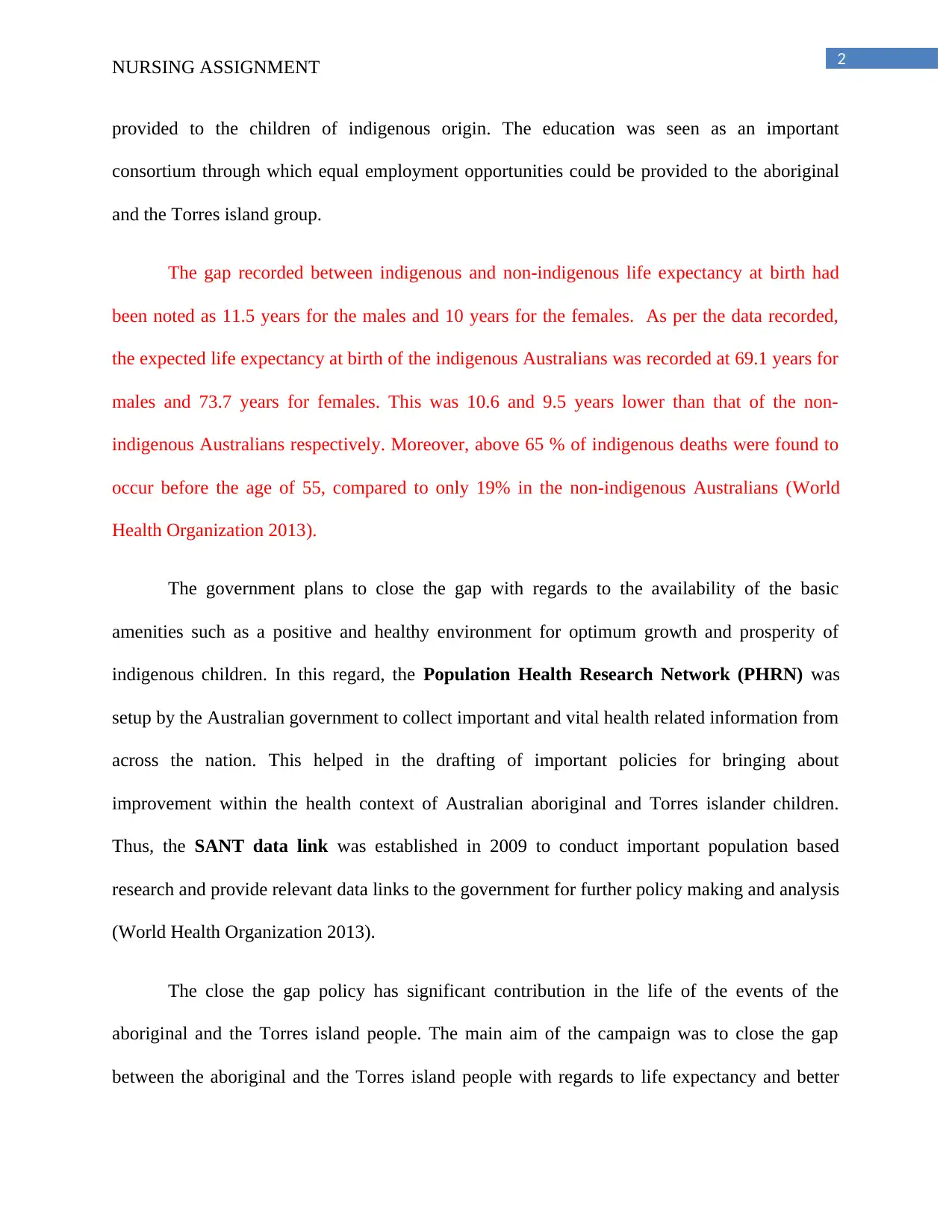
2NURSING ASSIGNMENT
provided to the children of indigenous origin. The education was seen as an important
consortium through which equal employment opportunities could be provided to the aboriginal
and the Torres island group.
The gap recorded between indigenous and non-indigenous life expectancy at birth had
been noted as 11.5 years for the males and 10 years for the females. As per the data recorded,
the expected life expectancy at birth of the indigenous Australians was recorded at 69.1 years for
males and 73.7 years for females. This was 10.6 and 9.5 years lower than that of the non-
indigenous Australians respectively. Moreover, above 65 % of indigenous deaths were found to
occur before the age of 55, compared to only 19% in the non-indigenous Australians (World
Health Organization 2013).
The government plans to close the gap with regards to the availability of the basic
amenities such as a positive and healthy environment for optimum growth and prosperity of
indigenous children. In this regard, the Population Health Research Network (PHRN) was
setup by the Australian government to collect important and vital health related information from
across the nation. This helped in the drafting of important policies for bringing about
improvement within the health context of Australian aboriginal and Torres islander children.
Thus, the SANT data link was established in 2009 to conduct important population based
research and provide relevant data links to the government for further policy making and analysis
(World Health Organization 2013).
The close the gap policy has significant contribution in the life of the events of the
aboriginal and the Torres island people. The main aim of the campaign was to close the gap
between the aboriginal and the Torres island people with regards to life expectancy and better
provided to the children of indigenous origin. The education was seen as an important
consortium through which equal employment opportunities could be provided to the aboriginal
and the Torres island group.
The gap recorded between indigenous and non-indigenous life expectancy at birth had
been noted as 11.5 years for the males and 10 years for the females. As per the data recorded,
the expected life expectancy at birth of the indigenous Australians was recorded at 69.1 years for
males and 73.7 years for females. This was 10.6 and 9.5 years lower than that of the non-
indigenous Australians respectively. Moreover, above 65 % of indigenous deaths were found to
occur before the age of 55, compared to only 19% in the non-indigenous Australians (World
Health Organization 2013).
The government plans to close the gap with regards to the availability of the basic
amenities such as a positive and healthy environment for optimum growth and prosperity of
indigenous children. In this regard, the Population Health Research Network (PHRN) was
setup by the Australian government to collect important and vital health related information from
across the nation. This helped in the drafting of important policies for bringing about
improvement within the health context of Australian aboriginal and Torres islander children.
Thus, the SANT data link was established in 2009 to conduct important population based
research and provide relevant data links to the government for further policy making and analysis
(World Health Organization 2013).
The close the gap policy has significant contribution in the life of the events of the
aboriginal and the Torres island people. The main aim of the campaign was to close the gap
between the aboriginal and the Torres island people with regards to life expectancy and better
⊘ This is a preview!⊘
Do you want full access?
Subscribe today to unlock all pages.

Trusted by 1+ million students worldwide
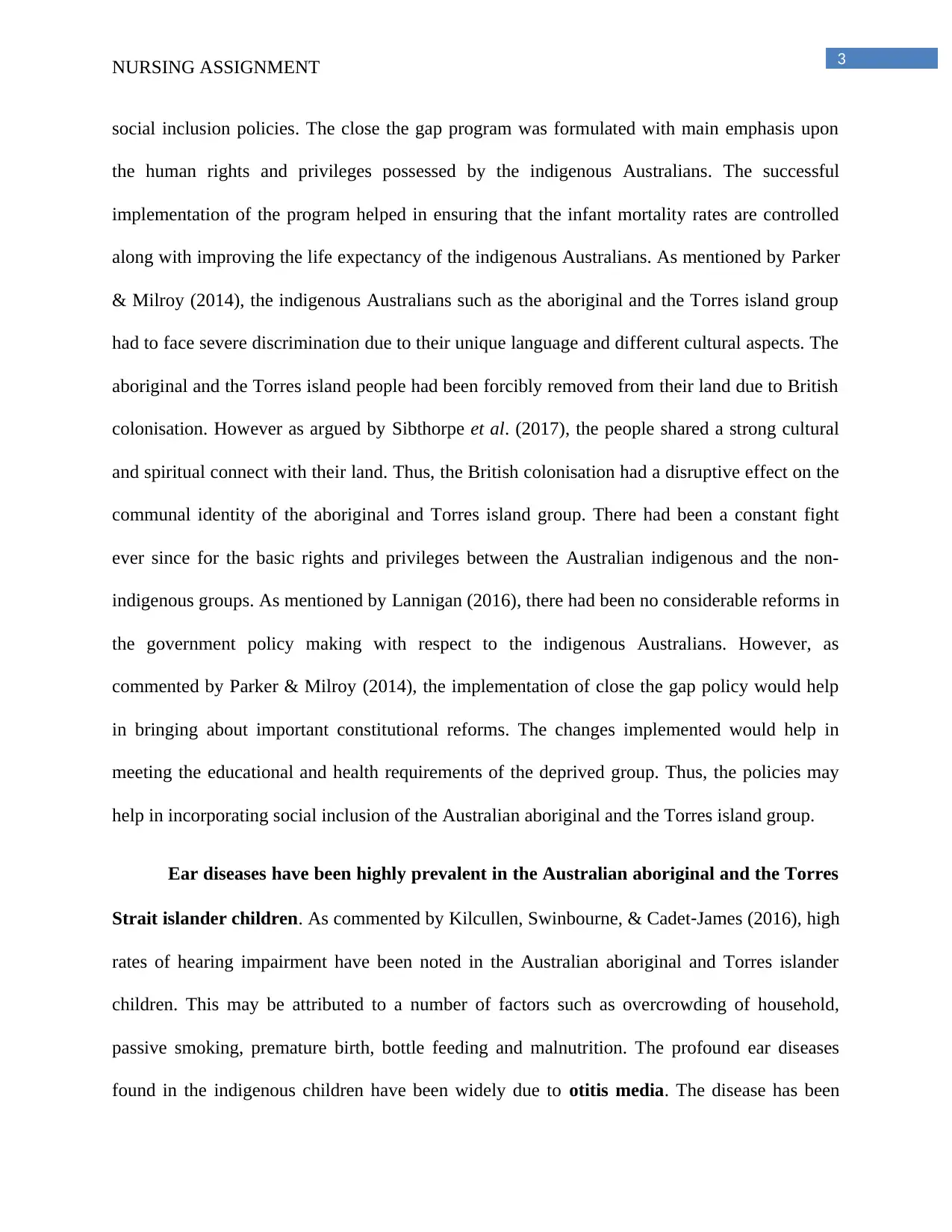
3NURSING ASSIGNMENT
social inclusion policies. The close the gap program was formulated with main emphasis upon
the human rights and privileges possessed by the indigenous Australians. The successful
implementation of the program helped in ensuring that the infant mortality rates are controlled
along with improving the life expectancy of the indigenous Australians. As mentioned by Parker
& Milroy (2014), the indigenous Australians such as the aboriginal and the Torres island group
had to face severe discrimination due to their unique language and different cultural aspects. The
aboriginal and the Torres island people had been forcibly removed from their land due to British
colonisation. However as argued by Sibthorpe et al. (2017), the people shared a strong cultural
and spiritual connect with their land. Thus, the British colonisation had a disruptive effect on the
communal identity of the aboriginal and Torres island group. There had been a constant fight
ever since for the basic rights and privileges between the Australian indigenous and the non-
indigenous groups. As mentioned by Lannigan (2016), there had been no considerable reforms in
the government policy making with respect to the indigenous Australians. However, as
commented by Parker & Milroy (2014), the implementation of close the gap policy would help
in bringing about important constitutional reforms. The changes implemented would help in
meeting the educational and health requirements of the deprived group. Thus, the policies may
help in incorporating social inclusion of the Australian aboriginal and the Torres island group.
Ear diseases have been highly prevalent in the Australian aboriginal and the Torres
Strait islander children. As commented by Kilcullen, Swinbourne, & Cadet‐James (2016), high
rates of hearing impairment have been noted in the Australian aboriginal and Torres islander
children. This may be attributed to a number of factors such as overcrowding of household,
passive smoking, premature birth, bottle feeding and malnutrition. The profound ear diseases
found in the indigenous children have been widely due to otitis media. The disease has been
social inclusion policies. The close the gap program was formulated with main emphasis upon
the human rights and privileges possessed by the indigenous Australians. The successful
implementation of the program helped in ensuring that the infant mortality rates are controlled
along with improving the life expectancy of the indigenous Australians. As mentioned by Parker
& Milroy (2014), the indigenous Australians such as the aboriginal and the Torres island group
had to face severe discrimination due to their unique language and different cultural aspects. The
aboriginal and the Torres island people had been forcibly removed from their land due to British
colonisation. However as argued by Sibthorpe et al. (2017), the people shared a strong cultural
and spiritual connect with their land. Thus, the British colonisation had a disruptive effect on the
communal identity of the aboriginal and Torres island group. There had been a constant fight
ever since for the basic rights and privileges between the Australian indigenous and the non-
indigenous groups. As mentioned by Lannigan (2016), there had been no considerable reforms in
the government policy making with respect to the indigenous Australians. However, as
commented by Parker & Milroy (2014), the implementation of close the gap policy would help
in bringing about important constitutional reforms. The changes implemented would help in
meeting the educational and health requirements of the deprived group. Thus, the policies may
help in incorporating social inclusion of the Australian aboriginal and the Torres island group.
Ear diseases have been highly prevalent in the Australian aboriginal and the Torres
Strait islander children. As commented by Kilcullen, Swinbourne, & Cadet‐James (2016), high
rates of hearing impairment have been noted in the Australian aboriginal and Torres islander
children. This may be attributed to a number of factors such as overcrowding of household,
passive smoking, premature birth, bottle feeding and malnutrition. The profound ear diseases
found in the indigenous children have been widely due to otitis media. The disease has been
Paraphrase This Document
Need a fresh take? Get an instant paraphrase of this document with our AI Paraphraser
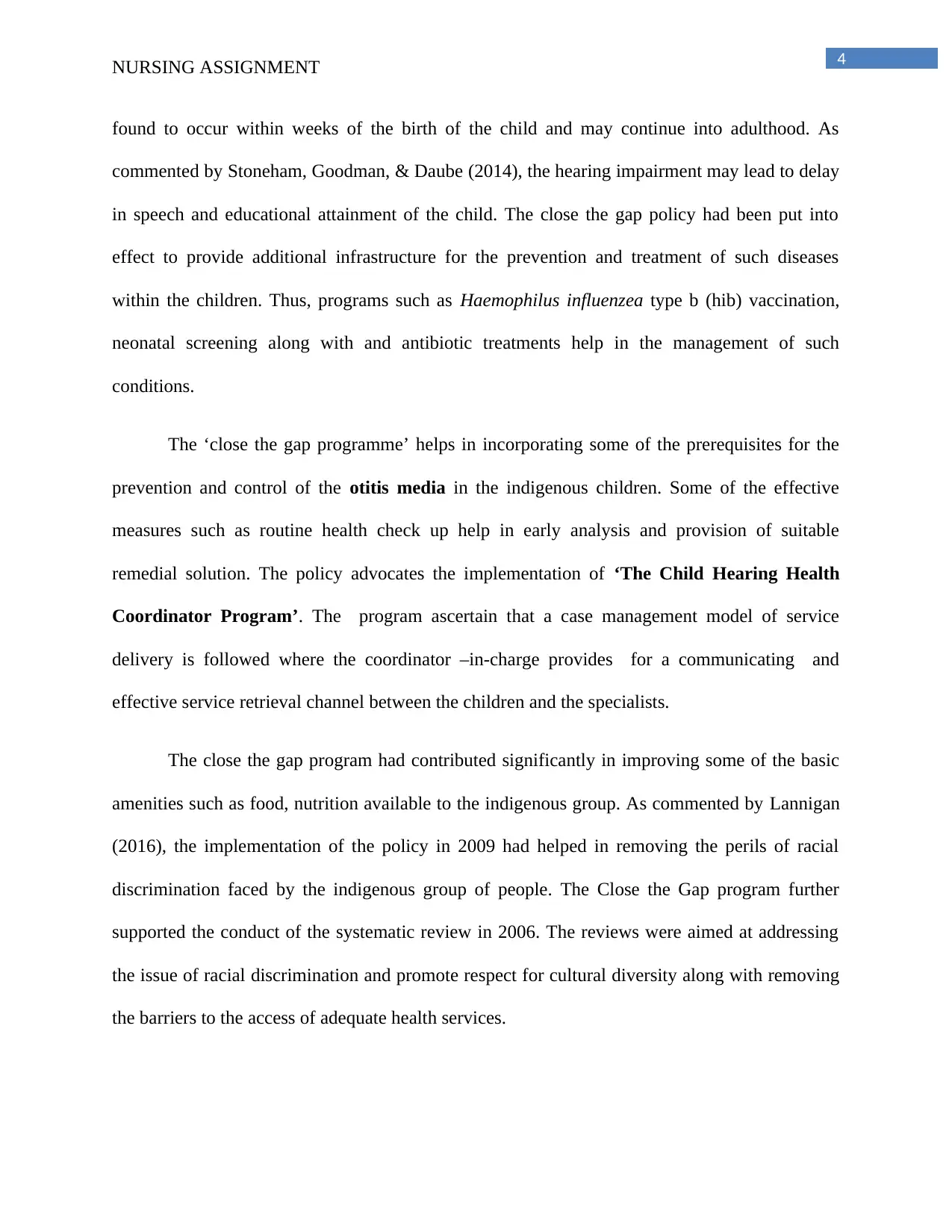
4NURSING ASSIGNMENT
found to occur within weeks of the birth of the child and may continue into adulthood. As
commented by Stoneham, Goodman, & Daube (2014), the hearing impairment may lead to delay
in speech and educational attainment of the child. The close the gap policy had been put into
effect to provide additional infrastructure for the prevention and treatment of such diseases
within the children. Thus, programs such as Haemophilus influenzea type b (hib) vaccination,
neonatal screening along with and antibiotic treatments help in the management of such
conditions.
The ‘close the gap programme’ helps in incorporating some of the prerequisites for the
prevention and control of the otitis media in the indigenous children. Some of the effective
measures such as routine health check up help in early analysis and provision of suitable
remedial solution. The policy advocates the implementation of ‘The Child Hearing Health
Coordinator Program’. The program ascertain that a case management model of service
delivery is followed where the coordinator –in-charge provides for a communicating and
effective service retrieval channel between the children and the specialists.
The close the gap program had contributed significantly in improving some of the basic
amenities such as food, nutrition available to the indigenous group. As commented by Lannigan
(2016), the implementation of the policy in 2009 had helped in removing the perils of racial
discrimination faced by the indigenous group of people. The Close the Gap program further
supported the conduct of the systematic review in 2006. The reviews were aimed at addressing
the issue of racial discrimination and promote respect for cultural diversity along with removing
the barriers to the access of adequate health services.
found to occur within weeks of the birth of the child and may continue into adulthood. As
commented by Stoneham, Goodman, & Daube (2014), the hearing impairment may lead to delay
in speech and educational attainment of the child. The close the gap policy had been put into
effect to provide additional infrastructure for the prevention and treatment of such diseases
within the children. Thus, programs such as Haemophilus influenzea type b (hib) vaccination,
neonatal screening along with and antibiotic treatments help in the management of such
conditions.
The ‘close the gap programme’ helps in incorporating some of the prerequisites for the
prevention and control of the otitis media in the indigenous children. Some of the effective
measures such as routine health check up help in early analysis and provision of suitable
remedial solution. The policy advocates the implementation of ‘The Child Hearing Health
Coordinator Program’. The program ascertain that a case management model of service
delivery is followed where the coordinator –in-charge provides for a communicating and
effective service retrieval channel between the children and the specialists.
The close the gap program had contributed significantly in improving some of the basic
amenities such as food, nutrition available to the indigenous group. As commented by Lannigan
(2016), the implementation of the policy in 2009 had helped in removing the perils of racial
discrimination faced by the indigenous group of people. The Close the Gap program further
supported the conduct of the systematic review in 2006. The reviews were aimed at addressing
the issue of racial discrimination and promote respect for cultural diversity along with removing
the barriers to the access of adequate health services.
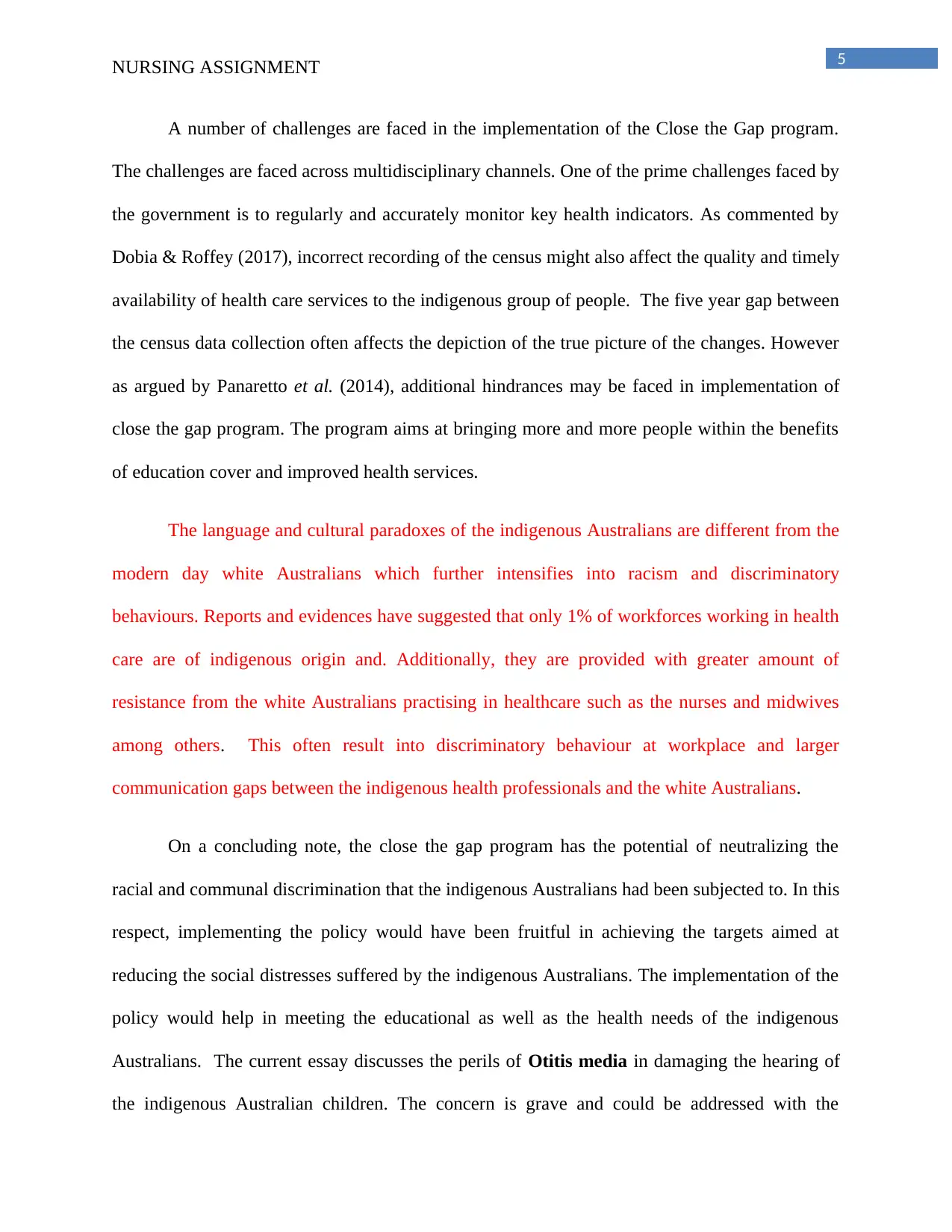
5NURSING ASSIGNMENT
A number of challenges are faced in the implementation of the Close the Gap program.
The challenges are faced across multidisciplinary channels. One of the prime challenges faced by
the government is to regularly and accurately monitor key health indicators. As commented by
Dobia & Roffey (2017), incorrect recording of the census might also affect the quality and timely
availability of health care services to the indigenous group of people. The five year gap between
the census data collection often affects the depiction of the true picture of the changes. However
as argued by Panaretto et al. (2014), additional hindrances may be faced in implementation of
close the gap program. The program aims at bringing more and more people within the benefits
of education cover and improved health services.
The language and cultural paradoxes of the indigenous Australians are different from the
modern day white Australians which further intensifies into racism and discriminatory
behaviours. Reports and evidences have suggested that only 1% of workforces working in health
care are of indigenous origin and. Additionally, they are provided with greater amount of
resistance from the white Australians practising in healthcare such as the nurses and midwives
among others. This often result into discriminatory behaviour at workplace and larger
communication gaps between the indigenous health professionals and the white Australians.
On a concluding note, the close the gap program has the potential of neutralizing the
racial and communal discrimination that the indigenous Australians had been subjected to. In this
respect, implementing the policy would have been fruitful in achieving the targets aimed at
reducing the social distresses suffered by the indigenous Australians. The implementation of the
policy would help in meeting the educational as well as the health needs of the indigenous
Australians. The current essay discusses the perils of Otitis media in damaging the hearing of
the indigenous Australian children. The concern is grave and could be addressed with the
A number of challenges are faced in the implementation of the Close the Gap program.
The challenges are faced across multidisciplinary channels. One of the prime challenges faced by
the government is to regularly and accurately monitor key health indicators. As commented by
Dobia & Roffey (2017), incorrect recording of the census might also affect the quality and timely
availability of health care services to the indigenous group of people. The five year gap between
the census data collection often affects the depiction of the true picture of the changes. However
as argued by Panaretto et al. (2014), additional hindrances may be faced in implementation of
close the gap program. The program aims at bringing more and more people within the benefits
of education cover and improved health services.
The language and cultural paradoxes of the indigenous Australians are different from the
modern day white Australians which further intensifies into racism and discriminatory
behaviours. Reports and evidences have suggested that only 1% of workforces working in health
care are of indigenous origin and. Additionally, they are provided with greater amount of
resistance from the white Australians practising in healthcare such as the nurses and midwives
among others. This often result into discriminatory behaviour at workplace and larger
communication gaps between the indigenous health professionals and the white Australians.
On a concluding note, the close the gap program has the potential of neutralizing the
racial and communal discrimination that the indigenous Australians had been subjected to. In this
respect, implementing the policy would have been fruitful in achieving the targets aimed at
reducing the social distresses suffered by the indigenous Australians. The implementation of the
policy would help in meeting the educational as well as the health needs of the indigenous
Australians. The current essay discusses the perils of Otitis media in damaging the hearing of
the indigenous Australian children. The concern is grave and could be addressed with the
⊘ This is a preview!⊘
Do you want full access?
Subscribe today to unlock all pages.

Trusted by 1+ million students worldwide
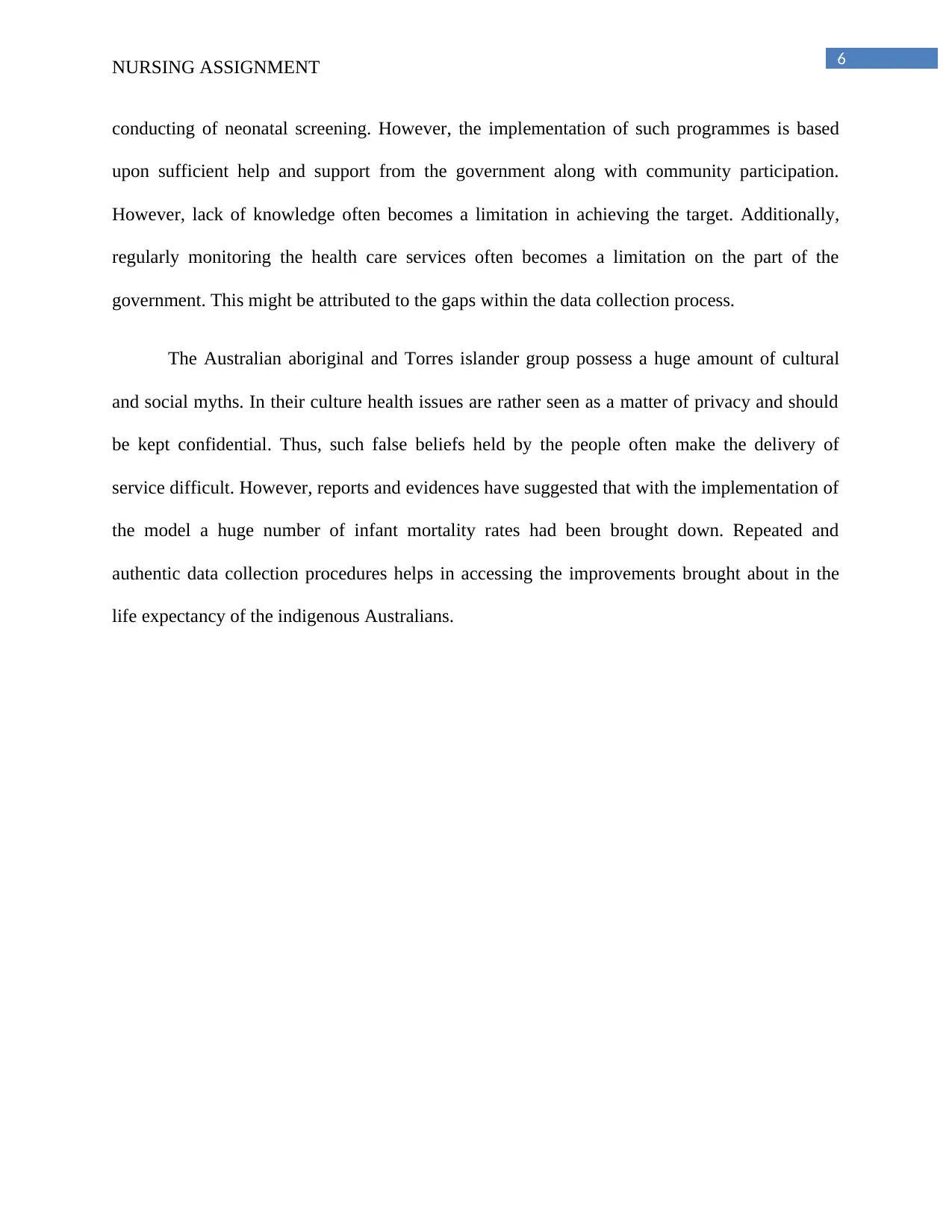
6NURSING ASSIGNMENT
conducting of neonatal screening. However, the implementation of such programmes is based
upon sufficient help and support from the government along with community participation.
However, lack of knowledge often becomes a limitation in achieving the target. Additionally,
regularly monitoring the health care services often becomes a limitation on the part of the
government. This might be attributed to the gaps within the data collection process.
The Australian aboriginal and Torres islander group possess a huge amount of cultural
and social myths. In their culture health issues are rather seen as a matter of privacy and should
be kept confidential. Thus, such false beliefs held by the people often make the delivery of
service difficult. However, reports and evidences have suggested that with the implementation of
the model a huge number of infant mortality rates had been brought down. Repeated and
authentic data collection procedures helps in accessing the improvements brought about in the
life expectancy of the indigenous Australians.
conducting of neonatal screening. However, the implementation of such programmes is based
upon sufficient help and support from the government along with community participation.
However, lack of knowledge often becomes a limitation in achieving the target. Additionally,
regularly monitoring the health care services often becomes a limitation on the part of the
government. This might be attributed to the gaps within the data collection process.
The Australian aboriginal and Torres islander group possess a huge amount of cultural
and social myths. In their culture health issues are rather seen as a matter of privacy and should
be kept confidential. Thus, such false beliefs held by the people often make the delivery of
service difficult. However, reports and evidences have suggested that with the implementation of
the model a huge number of infant mortality rates had been brought down. Repeated and
authentic data collection procedures helps in accessing the improvements brought about in the
life expectancy of the indigenous Australians.
Paraphrase This Document
Need a fresh take? Get an instant paraphrase of this document with our AI Paraphraser
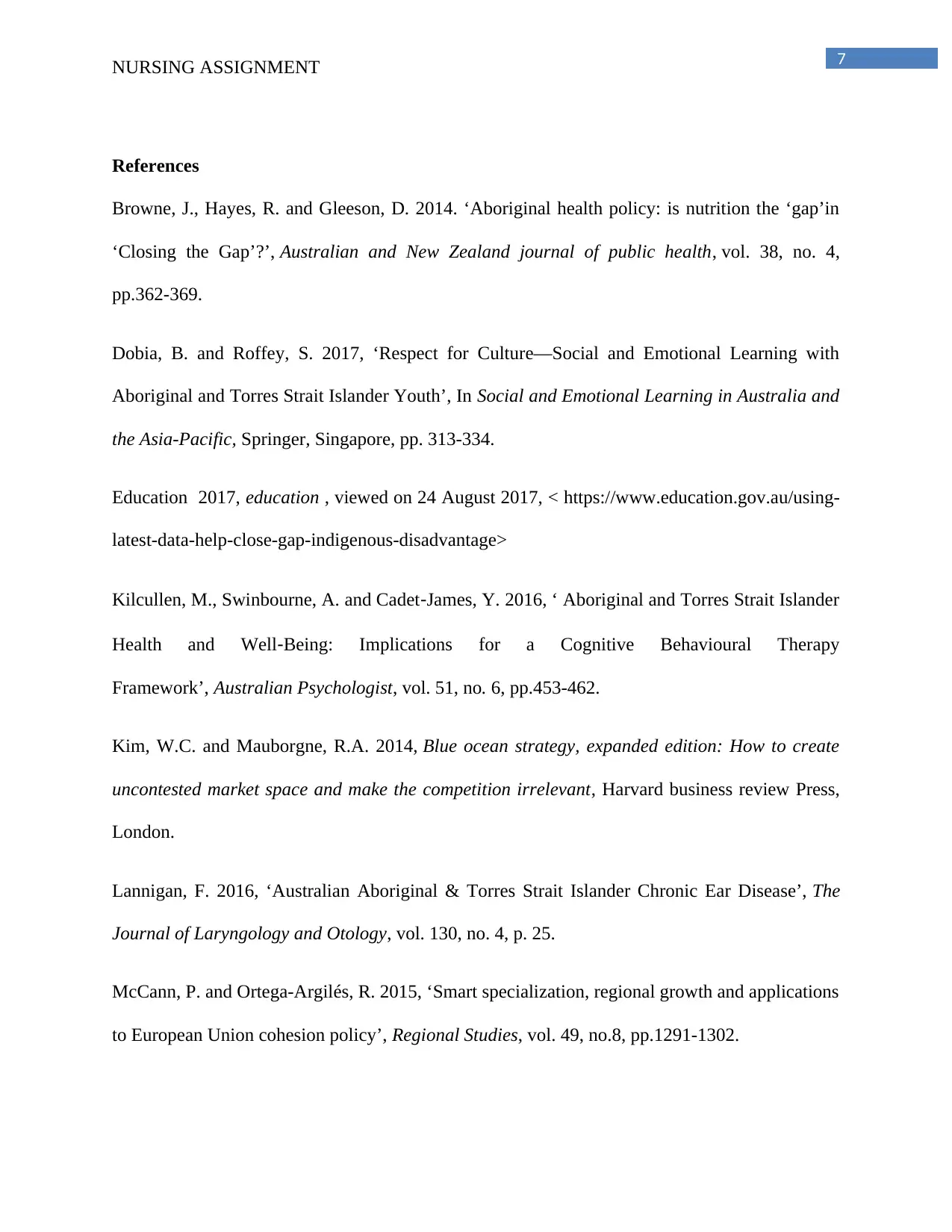
7NURSING ASSIGNMENT
References
Browne, J., Hayes, R. and Gleeson, D. 2014. ‘Aboriginal health policy: is nutrition the ‘gap’in
‘Closing the Gap’?’, Australian and New Zealand journal of public health, vol. 38, no. 4,
pp.362-369.
Dobia, B. and Roffey, S. 2017, ‘Respect for Culture—Social and Emotional Learning with
Aboriginal and Torres Strait Islander Youth’, In Social and Emotional Learning in Australia and
the Asia-Pacific, Springer, Singapore, pp. 313-334.
Education 2017, education , viewed on 24 August 2017, < https://www.education.gov.au/using-
latest-data-help-close-gap-indigenous-disadvantage>
Kilcullen, M., Swinbourne, A. and Cadet‐James, Y. 2016, ‘ Aboriginal and Torres Strait Islander
Health and Well‐Being: Implications for a Cognitive Behavioural Therapy
Framework’, Australian Psychologist, vol. 51, no. 6, pp.453-462.
Kim, W.C. and Mauborgne, R.A. 2014, Blue ocean strategy, expanded edition: How to create
uncontested market space and make the competition irrelevant, Harvard business review Press,
London.
Lannigan, F. 2016, ‘Australian Aboriginal & Torres Strait Islander Chronic Ear Disease’, The
Journal of Laryngology and Otology, vol. 130, no. 4, p. 25.
McCann, P. and Ortega-Argilés, R. 2015, ‘Smart specialization, regional growth and applications
to European Union cohesion policy’, Regional Studies, vol. 49, no.8, pp.1291-1302.
References
Browne, J., Hayes, R. and Gleeson, D. 2014. ‘Aboriginal health policy: is nutrition the ‘gap’in
‘Closing the Gap’?’, Australian and New Zealand journal of public health, vol. 38, no. 4,
pp.362-369.
Dobia, B. and Roffey, S. 2017, ‘Respect for Culture—Social and Emotional Learning with
Aboriginal and Torres Strait Islander Youth’, In Social and Emotional Learning in Australia and
the Asia-Pacific, Springer, Singapore, pp. 313-334.
Education 2017, education , viewed on 24 August 2017, < https://www.education.gov.au/using-
latest-data-help-close-gap-indigenous-disadvantage>
Kilcullen, M., Swinbourne, A. and Cadet‐James, Y. 2016, ‘ Aboriginal and Torres Strait Islander
Health and Well‐Being: Implications for a Cognitive Behavioural Therapy
Framework’, Australian Psychologist, vol. 51, no. 6, pp.453-462.
Kim, W.C. and Mauborgne, R.A. 2014, Blue ocean strategy, expanded edition: How to create
uncontested market space and make the competition irrelevant, Harvard business review Press,
London.
Lannigan, F. 2016, ‘Australian Aboriginal & Torres Strait Islander Chronic Ear Disease’, The
Journal of Laryngology and Otology, vol. 130, no. 4, p. 25.
McCann, P. and Ortega-Argilés, R. 2015, ‘Smart specialization, regional growth and applications
to European Union cohesion policy’, Regional Studies, vol. 49, no.8, pp.1291-1302.
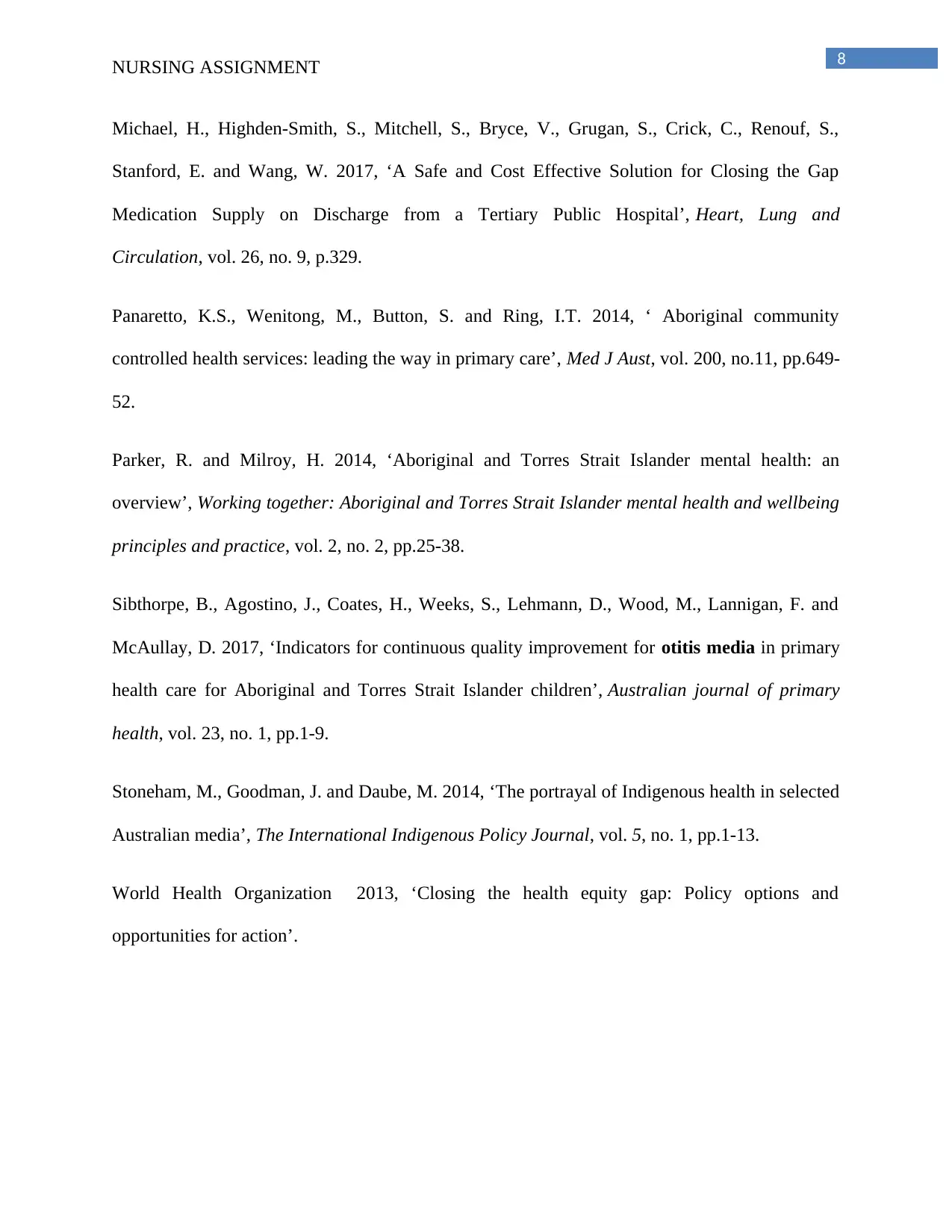
8NURSING ASSIGNMENT
Michael, H., Highden-Smith, S., Mitchell, S., Bryce, V., Grugan, S., Crick, C., Renouf, S.,
Stanford, E. and Wang, W. 2017, ‘A Safe and Cost Effective Solution for Closing the Gap
Medication Supply on Discharge from a Tertiary Public Hospital’, Heart, Lung and
Circulation, vol. 26, no. 9, p.329.
Panaretto, K.S., Wenitong, M., Button, S. and Ring, I.T. 2014, ‘ Aboriginal community
controlled health services: leading the way in primary care’, Med J Aust, vol. 200, no.11, pp.649-
52.
Parker, R. and Milroy, H. 2014, ‘Aboriginal and Torres Strait Islander mental health: an
overview’, Working together: Aboriginal and Torres Strait Islander mental health and wellbeing
principles and practice, vol. 2, no. 2, pp.25-38.
Sibthorpe, B., Agostino, J., Coates, H., Weeks, S., Lehmann, D., Wood, M., Lannigan, F. and
McAullay, D. 2017, ‘Indicators for continuous quality improvement for otitis media in primary
health care for Aboriginal and Torres Strait Islander children’, Australian journal of primary
health, vol. 23, no. 1, pp.1-9.
Stoneham, M., Goodman, J. and Daube, M. 2014, ‘The portrayal of Indigenous health in selected
Australian media’, The International Indigenous Policy Journal, vol. 5, no. 1, pp.1-13.
World Health Organization 2013, ‘Closing the health equity gap: Policy options and
opportunities for action’.
Michael, H., Highden-Smith, S., Mitchell, S., Bryce, V., Grugan, S., Crick, C., Renouf, S.,
Stanford, E. and Wang, W. 2017, ‘A Safe and Cost Effective Solution for Closing the Gap
Medication Supply on Discharge from a Tertiary Public Hospital’, Heart, Lung and
Circulation, vol. 26, no. 9, p.329.
Panaretto, K.S., Wenitong, M., Button, S. and Ring, I.T. 2014, ‘ Aboriginal community
controlled health services: leading the way in primary care’, Med J Aust, vol. 200, no.11, pp.649-
52.
Parker, R. and Milroy, H. 2014, ‘Aboriginal and Torres Strait Islander mental health: an
overview’, Working together: Aboriginal and Torres Strait Islander mental health and wellbeing
principles and practice, vol. 2, no. 2, pp.25-38.
Sibthorpe, B., Agostino, J., Coates, H., Weeks, S., Lehmann, D., Wood, M., Lannigan, F. and
McAullay, D. 2017, ‘Indicators for continuous quality improvement for otitis media in primary
health care for Aboriginal and Torres Strait Islander children’, Australian journal of primary
health, vol. 23, no. 1, pp.1-9.
Stoneham, M., Goodman, J. and Daube, M. 2014, ‘The portrayal of Indigenous health in selected
Australian media’, The International Indigenous Policy Journal, vol. 5, no. 1, pp.1-13.
World Health Organization 2013, ‘Closing the health equity gap: Policy options and
opportunities for action’.
⊘ This is a preview!⊘
Do you want full access?
Subscribe today to unlock all pages.

Trusted by 1+ million students worldwide
1 out of 9
Related Documents
Your All-in-One AI-Powered Toolkit for Academic Success.
+13062052269
info@desklib.com
Available 24*7 on WhatsApp / Email
![[object Object]](/_next/static/media/star-bottom.7253800d.svg)
Unlock your academic potential
Copyright © 2020–2025 A2Z Services. All Rights Reserved. Developed and managed by ZUCOL.





